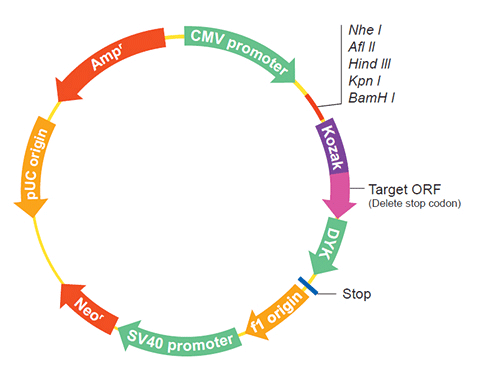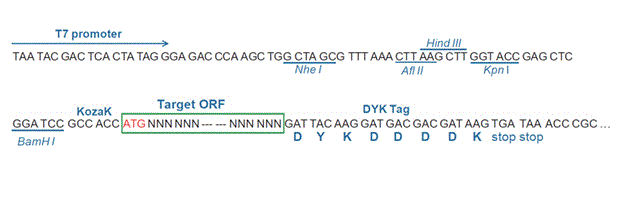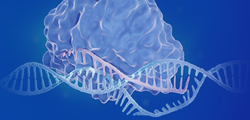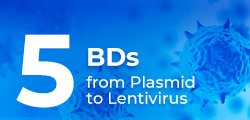| Gene Symbol | CPR11 |
| Entrez Gene ID | 100576090 |
| Full Name | cuticular protein 11 |
| Synonyms | AmelCPR11 |
| Gene Type | protein-coding |
| Organism | Apis mellifera(honey bee) |
-
REAGENT SERVICES
Hot!
-
Most Popular Services
-
Molecular Biology
-
Recombinant Antibody/Protein
-
Reagent Antibody
-
CRISPR Gene Editing
-
DNA Mutant Library
-
IVT RNA and LNP Formulations
-
Oligo Synthesis
-
Peptides
-
Cell Engineering
-
- Gene Synthesis FLASH Gene
- GenBrick™ Up to 200kb
- Gene Fragments Up to 3kb now
- Plasmid DNA Preparation Upgraded
- Cloning and Subcloning
- ORF cDNA Clones
- mRNA Plasmid Solutions New!
- Cell free mRNA Template New!
- AAV Plasmid Solutions New!
- Mutagenesis
- GenCircle™ Double-Stranded DNA New!
- GenSmart™ Online Tools
-
-
PRODUCTS
-
Most Popular Reagents
-
 Instruments
Instruments
-
Antibodies
-
ELISA Kits
-
Protein Electrophoresis and Blotting
-
Protein and Antibody Purification
-
Recombinant Proteins
-
Molecular Biology
-
Stable Cell Lines
-
Cell Isolation and Activation
-
 IVD Raw Materials
IVD Raw Materials
-
 Therapy Applications
Therapy Applications
-
Resources
-
- All Instruments
- Automated Protein and Antibody Purification SystemNew!
- Automated Plasmid MaxiprepHot!
- Automated Plasmid/Protein/Antibody Mini-scale Purification
- eBlot™ Protein Transfer System
- eStain™ Protein Staining System
- eZwest™ Lite Automated Western Blotting Device
- CytoSinct™ 1000 Cell Isolation Instrument
-
- Pharmacokinetics and Immunogenicity ELISA Kits
- Viral Titration QC ELISA Kits
- -- Lentivirus Titer p24 ELISA KitHot!
- -- MuLV Titer p30 ELISA KitNew!
- -- AAV2 and AAVX Titer Capsid ELISA Kits
- Residual Detection ELISA Kits
- -- T7 RNA Polymerase ELISA KitNew!
- -- BSA ELISA Kit, 2G
- -- Cas9 ELISA KitHot!
- -- Protein A ELISA KitHot!
- -- His tagged protein detection & purification
- dsRNA ELISA Kit
- Endonuclease ELISA Kit
- COVID-19 Detection cPass™ Technology Kits
-
- Automated Maxi-Plasmid PurificationHot!
- Automated Mini-Plasmid PurificationNew!
- PCR Reagents
- S.marcescens Nuclease Benz-Neburase™
- DNA Assembly GenBuilder™
- Cas9 / Cas12a / Cas13a Nucleases
- Base and Prime Editing Nucleases
- GMP Cas9 Nucleases
- CRISPR sgRNA Synthesis
- HDR Knock-in Template
- CRISPR Gene Editing Kits and Antibodies
-
![AmMag™ Quatro Automated Plasmid Purification]() AmMag™ Quatro automated plasmid purification
AmMag™ Quatro automated plasmid purification
-
![Anti-Camelid VHH]() MonoRab™ Anti-VHH Antibodies
MonoRab™ Anti-VHH Antibodies
-
![ELISA Kits]() ELISA Kits
ELISA Kits
-
![Precast Gels]() SurePAGE™ Precast Gels
SurePAGE™ Precast Gels
-
![Quatro ProAb Automated Protein and Antibody Purification System]() AmMag™ Quatro ProAb Automated Protein and Antibody Purification System
AmMag™ Quatro ProAb Automated Protein and Antibody Purification System
-
![Target Proteins]() Target Proteins
Target Proteins
-
![AmMag™ Quatro Automated Plasmid Purification]() AmMag™ Quatro automated plasmid purification
AmMag™ Quatro automated plasmid purification
-
![Stable Cell Lines]() Stable Cell Lines
Stable Cell Lines
-
![Cell Isolation and Activation]() Cell Isolation and Activation
Cell Isolation and Activation
-
 IVD Raw Materials
IVD Raw Materials
-
![Quick
Order]() Quick Order
Quick Order
-
![Quick
Order]() Quick Order
Quick Order
- APPLICATIONS
- RESOURCES
- ABOUT US
- SIGN IN My Account SIGN OUT
- REGISTER
ORF » Species Summary » Apis mellifera » CPR11 cDNA ORF clone
CPR11 cDNA ORF clone, Apis mellifera(honey bee)
-
Gene
-
Clones
gRNAs
-
Summary
-
mRNA and Protein(s)
mRNA Protein Name NM_001270823.1 NP_001257752.1 cuticular protein 11 precursor -
Pathways from BioSystems

-
Gene Ontology

-
Bibliography
Related articles in PubMed
Finding the missing honey bee genes: lessons learned from a genome upgrade.
Elsik CG, Worley KC, Bennett AK, Beye M, Camara F, Childers CP, de Graaf DC, Debyser G, Deng J, Devreese B, Elhaik E, Evans JD, Foster LJ, Graur D, Guigo R, , Hoff KJ, Holder ME, Hudson ME, Hunt GJ, Jiang H, Joshi V, Khetani RS, Kosarev P, Kovar CL, Ma J, Maleszka R, Moritz RF, Munoz-Torres MC, Murphy TD, Muzny DM, Newsham IF, Reese JT, Robertson HM, Robinson GE, Rueppell O, Solovyev V, Stanke M, Stolle E, Tsuruda JM, Vaerenbergh MV, Waterhouse RM, Weaver DB, Whitfield CW, Wu Y, Zdobnov EM, Zhang L, Zhu D, Gibbs RA,
BMC genomics1586(2014 Jan)GeneRIFs: Gene References Into Functions What's a GeneRIF?
The following CPR11 gene cDNA ORF clone sequences were retrieved from the NCBI Reference Sequence Database (RefSeq). These sequences represent the protein coding region of the CPR11 cDNA ORF which is encoded by the open reading frame (ORF) sequence. ORF sequences can be delivered in our standard vector, pcDNA3.1+/C-(K)DYK or the vector of your choice as an expression/transfection-ready ORF clone. Not the clone you want? Click here to find your clone.
-
Reference Sequences (Refseq)
CloneID OHd00240 Clone ID Related Accession (Same CDS sequence) NM_001270823.1 Accession Version NM_001270823.1 Latest version! Documents for ORF clone product in default vector Sequence Information ORF Nucleotide Sequence (Length: 498bp)
Protein sequence
SNPVector pcDNA3.1-C-(k)DYK or customized vector  User Manual
User ManualClone information Clone Map  MSDS
MSDSTag on pcDNA3.1+/C-(K)DYK C terminal DYKDDDDK tags ORF Insert Method CloneEZ™ Seamless cloning technology Insert Structure linear Update Date 1545062400000 Organism Apis mellifera(honey bee) Product cuticular protein 11 precursor Comment Comment: VALIDATED REFSEQ: This record has undergone validation or preliminary review. The reference sequence was derived from QIUM02000036.1. On Aug 4, 2012 this sequence version replaced XM_003249903.1. Sequence Note: The RefSeq transcript and protein were derived from genomic sequence to make the sequence consistent with the reference genome assembly. The genomic coordinates used for the transcript record were based on alignments. ##Evidence-Data-START## Transcript exon combination :: HP521270.1 [ECO:0000332] RNAseq introns :: single sample supports all introns SAMN00996631, SAMN01985568 [ECO:0000348] ##Evidence-Data-END##
1
61
121
181
241
301
361
421
481ATGGAGTCGA AGAGCCTGCT CGTTCCTGCT GCGGTCTTGC TGCTAACCCT CGCCCTCCAC
GTCGTACAAT CGACGAGCTA TCACGATTTG GACAACGAGG ATGCTGGCAG CGAACACGGA
CACGGGGGAG GAGGTGGACA CGGGGGAGGA GGTGGACACG CTCACTCCTT CCATCACTTC
TCTGGGCCAG TAGTGGGCCA TCACGAAGAG GTCACGTGGA AGGACAAACA CGGGCATCTT
CATCACGACT ACAGGGCCCA TCCCAAGTAC AAGTTCGCGT ACGGCGTGGA CGACAAACAC
ACGAAGGATT TCCACGGGCA GAAAGAGCAT CGCGATGGGA AAGAAGTGGA AGGGGAGTAC
CATCTTCACG AGCCCGGAGG CAACGTGAGA AGCGTTAAGT ACCATTCGGA TCCTCATGGA
GGTTTCTTCG CGGAAGTTCA CAATTATGGA GGAAACGATC ATTCAGGTGG CACTTATGGT
GGACATAAAC ACGGATAAThe stop codons will be deleted if pcDNA3.1+/C-(K)DYK vector is selected.
RefSeq NP_001257752.1 CDS 20..517 Translation 
Target ORF information:
RefSeq Version NM_001270823.1 Organism Apis mellifera(honey bee) Definition Apis mellifera cuticular protein 11 (CPR11), mRNA. Target ORF information:
Epitope DYKDDDDK Bacterial selection AMPR Mammalian selection NeoR Vector pcDNA3.1+/C-(K)DYK  NM_001270823.1
NM_001270823.1
ORF Insert Sequence:
1
61
121
181
241
301
361
421
481ATGGAGTCGA AGAGCCTGCT CGTTCCTGCT GCGGTCTTGC TGCTAACCCT CGCCCTCCAC
GTCGTACAAT CGACGAGCTA TCACGATTTG GACAACGAGG ATGCTGGCAG CGAACACGGA
CACGGGGGAG GAGGTGGACA CGGGGGAGGA GGTGGACACG CTCACTCCTT CCATCACTTC
TCTGGGCCAG TAGTGGGCCA TCACGAAGAG GTCACGTGGA AGGACAAACA CGGGCATCTT
CATCACGACT ACAGGGCCCA TCCCAAGTAC AAGTTCGCGT ACGGCGTGGA CGACAAACAC
ACGAAGGATT TCCACGGGCA GAAAGAGCAT CGCGATGGGA AAGAAGTGGA AGGGGAGTAC
CATCTTCACG AGCCCGGAGG CAACGTGAGA AGCGTTAAGT ACCATTCGGA TCCTCATGGA
GGTTTCTTCG CGGAAGTTCA CAATTATGGA GGAAACGATC ATTCAGGTGG CACTTATGGT
GGACATAAAC ACGGATAAThe stop codons will be deleted if pcDNA3.1+/C-(K)DYK vector is selected.
-
PubMed
Finding the missing honey bee genes: lessons learned from a genome upgrade.
BMC genomics1586(2014 Jan)
Elsik CG,Worley KC,Bennett AK,Beye M,Camara F,Childers CP,de Graaf DC,Debyser G,Deng J,Devreese B,Elhaik E,Evans JD,Foster LJ,Graur D,Guigo R,,Hoff KJ,Holder ME,Hudson ME,Hunt GJ,Jiang H,Joshi V,Khetani RS,Kosarev P,Kovar CL,Ma J,Maleszka R,Moritz RF,Munoz-Torres MC,Murphy TD,Muzny DM,Newsham IF,Reese JT,Robertson HM,Robinson GE,Rueppell O,Solovyev V,Stanke M,Stolle E,Tsuruda JM,Vaerenbergh MV,Waterhouse RM,Weaver DB,Whitfield CW,Wu Y,Zdobnov EM,Zhang L,Zhu D,Gibbs RA,
-
-
Most Popular Services
-
Services & Products
-
News & Blogs
- Boosting CAR-T cells with mRNA Vaccines: New Immunotherapy Strategy
- Transforming OMVs into a Modular Vaccine Platform | GenScript
- Designed protein mimetic stimulates cancer-fighting immune cells without toxic side effects
- Correcting Human Disease Mutations with CRISPR/Cas9-AAV Strategies
- First Successful Offspring Created Through the Cloning of A Non-Human Primate
- Four Decades of HIV Research: How Far We Have Come
- Antibody Escape Enhanced by Deletions in the SARS-CoV-2 Spike Glycoprotein
- Scientists Discovered the Surprising Links Between Sour Taste Perception and Sense of Balance
-
-
-
PubMed
 Hi!Ask me about GenScript services and products! I can answer questions or connect you to a live person.
Hi!Ask me about GenScript services and products! I can answer questions or connect you to a live person. -




































